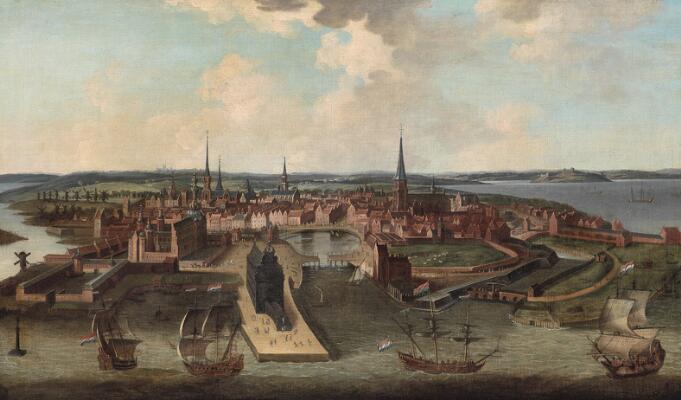Dutch painter, 17th century
View of Copenhagen c. 1650. Unsigned. Oil on canvas. 73×110 cm.
Purchased by Københavns Kommune, Kunst- og Kultur, for Københavns Museum
Several early prospects of Copenhagen reproduced as engravings are known. The earliest one “København set fra landsiden” (Copenhagen seen from the landside") is by Hans Knieper dated 1587.
Another example is Jan van Wijk's painting from 1611, where the city is seen from an imaginary point above Amager. It hung in Copenhagen's City Hall and was destroyed by fire in 1728. The painting is known from an engraving with the title “HAFNIA METROPOLIS ET PORTUS CELEBERRIMUS DANIA”: “København, Danmarks hovedstad og mest berømte havn” (Copenhagen, Denmark's capital and most famous port). Here, several of the city's significant buildings, e.g. Copenhagen Castle, Tøjhuset (the Arsenal) and Provianthuset (the Victualling House), which Christian IV had built, can be seen. In the present Copenhagen City Hall, which was inaugurated in 1905, a wall is adorned with a painting, the basis of which is the above mentioned engraving.
In John Erichsen's exhibition catalogue from Copenhagen City Museum, “Københavnske motiver 1587–1807” (Copenhagen motifs 1587–1807) from 1974, an etching is reproduced (cat. no. 6) and described as follows: “et ukendt blad kopieret 1642 efter van Wick med tilføjelse af Børsen” (an unknown sheet copied in 1642 after van Wijk with the addition of the Stock Exchange). This could be the source for the present painting.
Clement de Jonghe's engraving COPPEN-HAVEN also has points of similarity with the present painting. At the front, almost in the middle “Børsen” (the Stock Exchange) can be seen, which is one of Copenhagen's oldest buildings, built by the harbour at the end of the Castle Square on land surrounded by water on three sides. Below Børsen a bridge leads out into nothing! The construction of Børsen took place from 1619 to 1640. To the left of Børsen, you can see Copenhagen Castle and behind it Vor Frue Church (the Church of Our Lady) with the Gothic tower, lost in the Copenhagen fire in 1728.
Clement/Clemendt de Jongh/Ionghe (1624/25–1677) was one of the largest print and map dealers and publishers in Amsterdam. He was active from about 1647 until his death. (He is known from a famous engraving by Rembrandt). De Jonghe gives a colourful description of Copenhagen under his copper engraving COPPEN-HAVEN in French, Dutch and, as here, in Latin, see next page.
Hafnia delitium Borealis nobile Mundi, Terrarum fidus, Regis alumna Domus. Regia Neptuni, Themidos laudablile Templum Mercurii statio Martis et Artis amor Urbs peramoena situ formosa, et commoda victu, Quam nisi sit stupidus visere quisque velit Singula quæ si non hac videris urbe viator Ne cuiquam dicas Hafnia visa mihi est.
Copenhagen, the noble joy of the Nordics, The kingdom's ornament, the king's home. Neptune's abode, Themis's praiseworthy temple, Mercury's anchorage, the lover of Mars and the arts, The beautiful city and place with a pleasant life. Anyone who is not ungifted should wish to visit. You traveler, if you do not see every corner of this city, You cannot claim: “I've seen Copenhagen.”
The painting does not give a true picture of how Copenhagen looked like in the 17th century. The artist has found inspiration in contemporary pieces and has added something and removed something.
We are grateful to “Latinskolen” (the Latin school) in Gentofte for the translation of the Latin text.
Please note: The item is subject to the Anti-Money Laundering Act. In the event of a hammer price of DKK 50,000 or more, including buyer’s premium, the buyer must submit a copy of a valid photo ID and proof of address in order to collect the item.
Paintings & Drawings, 18 September 2023
